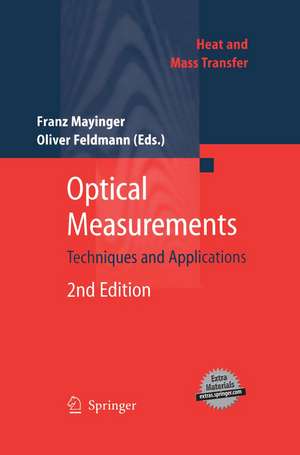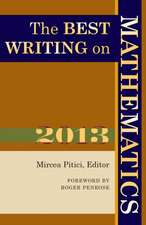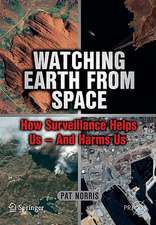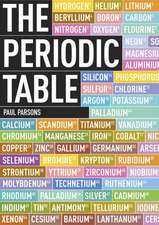Optical Measurements: Techniques and Applications: Heat and Mass Transfer
Editat de Oliver Feldmann, F. Mayingeren Limba Engleză Paperback – 3 oct 2013
| Toate formatele și edițiile | Preț | Express |
|---|---|---|
| Paperback (1) | 950.66 lei 6-8 săpt. | |
| Springer Berlin, Heidelberg – 3 oct 2013 | 950.66 lei 6-8 săpt. | |
| Hardback (1) | 956.81 lei 6-8 săpt. | |
| Springer Berlin, Heidelberg – 17 iul 2001 | 956.81 lei 6-8 săpt. |
Din seria Heat and Mass Transfer
- 18%
 Preț: 1002.27 lei
Preț: 1002.27 lei - 15%
 Preț: 637.78 lei
Preț: 637.78 lei - 15%
 Preț: 647.92 lei
Preț: 647.92 lei - 15%
 Preț: 579.99 lei
Preț: 579.99 lei - 15%
 Preț: 649.39 lei
Preț: 649.39 lei - 18%
 Preț: 948.79 lei
Preț: 948.79 lei - 18%
 Preț: 990.44 lei
Preț: 990.44 lei - 20%
 Preț: 993.74 lei
Preț: 993.74 lei - 18%
 Preț: 945.30 lei
Preț: 945.30 lei - 18%
 Preț: 887.24 lei
Preț: 887.24 lei - 15%
 Preț: 644.18 lei
Preț: 644.18 lei - 15%
 Preț: 645.28 lei
Preț: 645.28 lei - 18%
 Preț: 1236.19 lei
Preț: 1236.19 lei - 18%
 Preț: 950.96 lei
Preț: 950.96 lei - 18%
 Preț: 947.35 lei
Preț: 947.35 lei - 15%
 Preț: 636.12 lei
Preț: 636.12 lei - 18%
 Preț: 947.85 lei
Preț: 947.85 lei - 15%
 Preț: 639.41 lei
Preț: 639.41 lei - 18%
 Preț: 953.97 lei
Preț: 953.97 lei - 15%
 Preț: 640.88 lei
Preț: 640.88 lei - 15%
 Preț: 657.08 lei
Preț: 657.08 lei - 18%
 Preț: 957.62 lei
Preț: 957.62 lei - 18%
 Preț: 957.44 lei
Preț: 957.44 lei - 18%
 Preț: 943.25 lei
Preț: 943.25 lei - 18%
 Preț: 1049.44 lei
Preț: 1049.44 lei - 18%
 Preț: 955.70 lei
Preț: 955.70 lei - 15%
 Preț: 642.83 lei
Preț: 642.83 lei - 18%
 Preț: 1214.38 lei
Preț: 1214.38 lei - 15%
 Preț: 649.71 lei
Preț: 649.71 lei - 15%
 Preț: 645.47 lei
Preț: 645.47 lei - 18%
 Preț: 1002.13 lei
Preț: 1002.13 lei - 15%
 Preț: 636.12 lei
Preț: 636.12 lei
Preț: 950.66 lei
Preț vechi: 1159.34 lei
-18% Nou
Puncte Express: 1426
Preț estimativ în valută:
181.93€ • 189.24$ • 150.19£
181.93€ • 189.24$ • 150.19£
Carte tipărită la comandă
Livrare economică 12-26 aprilie
Preluare comenzi: 021 569.72.76
Specificații
ISBN-13: 9783642630798
ISBN-10: 3642630790
Pagini: 428
Ilustrații: XVII, 405 p.
Dimensiuni: 155 x 235 x 22 mm
Greutate: 0.59 kg
Ediția:2nd ed. 2001. Softcover reprint of the original 2nd ed. 2001
Editura: Springer Berlin, Heidelberg
Colecția Springer
Seria Heat and Mass Transfer
Locul publicării:Berlin, Heidelberg, Germany
ISBN-10: 3642630790
Pagini: 428
Ilustrații: XVII, 405 p.
Dimensiuni: 155 x 235 x 22 mm
Greutate: 0.59 kg
Ediția:2nd ed. 2001. Softcover reprint of the original 2nd ed. 2001
Editura: Springer Berlin, Heidelberg
Colecția Springer
Seria Heat and Mass Transfer
Locul publicării:Berlin, Heidelberg, Germany
Public țintă
ResearchCuprins
1 Introduction.- 2 The Schlieren Technique.- 2.1 Introduction.- 2.2 Basic Principle.- 2.3 Optical and Thermodynamic Interrelations.- 2.4 Application of the Schlieren Technique.- 3 Fundamentals of Holography and Interferometry.- 3.1 Abstract.- 3.2 Introduction.- 3.3 Principle of Holography.- 3.4 Simple Holographic Arrangement.- 3.5 Holographic Interferometry.- 3.6 An Interference Method for Simultaneous Heat and Mass Transfer.- 3.7 Comparison with Classical Methods.- 4 Holographic Interferometry.- 4.1 Introduction.- 4.2 Components of a Holographic Interferometer.- 4.3 Evaluation of Interferograms.- 4.4 Examples.- 5 Short Time Holography.- 5.1 Introduction.- 5.2 Elements of holography.- 5.3 Application example: Dispersion characteristics in stirred bubble columns.- 6 Evaluation of holograms by digital image processing.- 6.1 Introduction.- 6.2 A digital image processing system for the evaluation of holographic reconstructions.- 6.3 Image processing.- 6.4 Evaluation of interferograms.- 7 Light Scattering.- 7.1 Introduction.- 7.2 Scattering Processes.- 7.3 Light Scattering Techniques in Heat Transfer.- 7.4 Concluding Remarks.- 8 Laser—Doppler Velocimetry.- 8.1 Introduction.- 8.2 Principles of LDV.- 8.3 Optics.- 8.4 Signal Processing.- 8.5 Seeding Particles.- 8.6 Determination of Characteristic Turbulence-Quantities.- 9 Phase Doppler Anemometry (PDA).- 9.1 Introduction.- 9.2 General considerations for the application of PDA.- 9.3 Principles of PDA.- 9.4 Measurement accuracy.- 9.5 Applications of PDA.- 10 Dynamic Light Scattering.- 10.1 Introduction.- 10.2 Overview.- 10.3 Light Scattering Theory.- 10.4 Experimental Methods.- 10.5 Measurement of Thermal Diffusivity.- 11 Raman Scattering.- 11.1 Introduction.- 11.2 Theoretical Basics of Raman Spectroscopy.- 11.3 Experimentalset-up.- 11.4 Selected Applications.- 11.5 Concluding Remarks.- 12 Laser induced Fluorescence.- 12.1 Introduction.- 12.2 Basic Principles of Laser Induced Fluorescence.- 12.3 Experimental Setup and Procedures.- 12.4 Selected Applications.- 12.5 Concluding Remarks.- 13 Absorption.- 13.1 Introduction.- 13.2 Line spectra.- 13.3 Experimental techniques.- 14 Pyrometry and Thermography.- 14.1 Introduction.- 14.2 Temperature Radiation.- 14.3 Method of Transmission.- 14.4 Radiation Receiver (Detector).- 14.5 Thermal Cameras — Thermography Image Systems.- 14.6 Pyrometers.- 14.7 Error Potential.- 14.8 Appendix.- 15 Tomography.- 15.1 Introduction.- 15.2 Integral Measurement Methods.- 15.3 Mathematical Reconstruction Methods.- 15.4 Implementations.- 16 Particle Image Velocimetry.- 16.1 Introduction.- 16.2 Hardware for the experimental set-up.- 16.3 Evaluation software.- 16.4 Three-dimensional flow.- 16.5 Applications.- Nomenclature.- References.
Textul de pe ultima copertă
This book provides an introduction to the most important optical measurement techniques that are applied to engineering problems. It will also serve as a guideline to selecting and applying the appropriate technique to a particular problem. The text of the first edition has been completely revised and new chapters added to describe the latest developments in Phase-Doppler Velocimetry and Particle Image Velocimetry. The editors and authors have made a special effort not only to describe and to explain the fundamentals of measuring techniques, but also to provide guidelines for their application and to demonstrate the capabilities of the various methods. The book comes with a CD-ROM containing high-speed movies visualizing the methods described in the book.
Caracteristici
Includes supplementary material: sn.pub/extras






